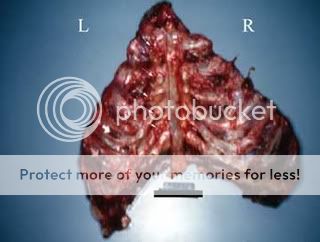usafmedic45
Forum Deputy Chief
- 3,796
- 5
- 0
the reason we do compressions away from the xiphoid process, is the xiphoid process is an anchor point for the diaphragm. You break that and away goes your interthoracic pressure
Care to provide some evidence to support that claim? I've never heard that and I used to work with a prof who did cardiac arrest research (not that the idea does not make sense from a mechanics of CPR standpoint, just that the chances are minimal of it actually happening.
The PRIMARY reason you don't compress over the xiphoid is the risk of liver laceration. Even with tremendous compressive trauma to the chest (such as plane crashes in the case of my study), it is very uncommon to see the rupture of a diaphragm solely at the anterior aspect. More often it involves the dome (center) of the diaphragm or in less common cases where there is avulsion of the diaphragm from the chest wall it is normally seen at the posterior aspect. This is possibly due to the differences in angle of connection between the anterior and posterior insertions of the diaphragm. Also, where the xiphoid is at, there are several reinforcing structures that lessen the chances of an iatrogenic perforation.
Here's an example of an injury to the diaphragm that demonstrates damage to the dome of the left leaflet of the diaphram:

In roughly five hundred cases of blunt chest trauma due to plane crashes- including cases where the body is fragmented- so far I have seen two cases of isolated injury to the medial diaphragm. Both of these cases involved avulsion of the sternum from the ribs and the heart was macerated (shredded). I am not saying that it cannot happen, but just that it is a highly unlikely occurence and not the primary concern for xiphoid process motion during chest compressions.
Yes, although most pulmonary complications of CPR are associated with the ventilation component which is one reason a couple of in-hospital research programs have reported (not sure if it has been published yet, speaking from conversations at the cardiac conference in Stavanger, Norway a couple of years back) a decrease in pneumothoraces with the decreased emphasis on ventilation during resuscitation.Couldn't you also puncture a lung?
Anyway, back to the story, the coroner ruled that the Paramedics broke the ribs when they gave the guy CPR!
It is not at all a rare event and sternal fractures are also seen as a not uncommon as a complication of CPR. In fact, in my injury research we use autopsy data and there is a variable in the database to indicate whether CPR was performed to be able to see if there was any effect (since I am also are looking at correlations between certain superficial injuries and internal injuries as a side project and do not want resuscitation trauma to skew the data).
That is less likely to do that than a rib fracture which is less likely than a pneumothorax due to excessive or overzealous ventilation. As one of my pathologist friends likes to say, "The most common cause of pneumothorax in resuscitation is eager EMTs named Bubba".you can break it off and it could puncture a lung
The majority of times, rib fractures are from blunt trauma (ie fall, MVC, assault) and are not going to produce external hemorrhage. There is a good likely hood of internal hemorrhage... maybe the internal hemorrhage is what you are referring to.
They are talking about hemorrhage around the fractured ends of the ribs. It looks like extreme bruising on the chest wall. The only way you get significant "internal" hemorrhage in the sense of a hemothorax would be if you did serious damage to multiple intercostal vessels or took out one of the internal mammary arteries.
Here is an example of what rib fractures look like at autopsy (looking from the interior surface of the chest, the xiphoid process can be seen in the middle at the bottom of the sternum):

The black/purple discoloration to the left of the upper arrows is the hemorrhage which is *usually* absent in post- or perimortem fractures.
Last edited by a moderator:
